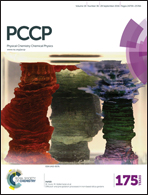In situ growth of MoS2 nanosheets on reduced graphene oxide (RGO) surfaces: interfacial enhancement of absorbing performance against electromagnetic pollution†
Abstract
Electromagnetic pollution is rising all over the world. Compared with electromagnetic waves reflection, electromagnetic absorption (EA) is a better choice to balance electromagnetic applications and human health. The highly conductive networks in composites, as well as in species, and the intensity of defect polarization are the most important factors to improving the EA performance of a dielectric material. In this study, an in situ one-pot hydrothermal growth of MoS2 layers on reduced graphene oxide (RGO) surfaces was developed for the synthesis of RGO/MoS2 nanosheets. With a filler loading ratio of 20 wt%, the composite of the RGO/MoS2 nanosheets could build conductive networks and exhibited an effective EA bandwidth (lower than −10 dB) of 5.7 GHz and a minimum reflection loss (RL) of −60 dB. The results revealed that the as-prepared RGO/MoS2 nanosheets are promising EA materials, with broad and strong absorption properties at a low filler loading and low thickness.


 Please wait while we load your content...
Please wait while we load your content...